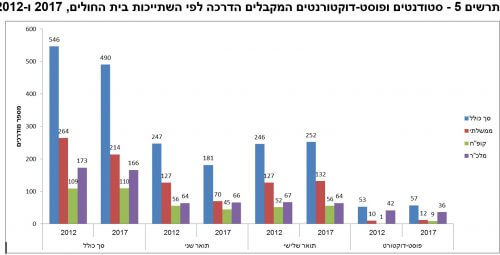Only half a percent of the civilian R&D budget in Israel is used to finance research in the field of health compared to 10% of the OECD average, according to a survey prepared for the National Council for Research and Development by the CBS * The main funders are the state, followed by a considerable margin by non-profits and health insurance funds

The distribution of civilian R&D funding by government ministries according to civilian R&D goals in 2017 and which was recently published, shows that health R&D funding is significantly lower in Israel compared to the average of OECD countries, half a percent in Israel compared to 10.1% of the OECD average . This is according to a survey conducted by the Central Bureau of Statistics.
In the hospitals in Israel, significant research activity is carried out both in substance and in the financial scope and the manpower invested in it. An R&D survey in hospitals in Israel was conducted for the first time in 2009 by the Central Bureau of Statistics in cooperation with and funded by the National Research and Development Council (R&D) under the Ministry of Science. The next survey was conducted in 2012, and in 2018 the survey was conducted for the third time. This survey referred to the R&D data with special funding in 2017 in general hospitals only, because in the previous survey it became clear that the research in mental hospitals is very small in scope.
A research and development survey questionnaire in general hospitals for 2017 was sent to all general hospitals in Israel. The topics investigated were: medical R&D expenses, funding from the various sources, the number of doctors with academic/clinical appointments and training of graduate and post-doctorate students.
In 2017, the total expenditures on specially funded research in general hospitals reached NIS 347.4 million. This is a decrease of 19.4% in 5 years.
64% of the total research expenses were carried out in government hospitals, 22% in non-profit hospitals and 14% in KofH hospitals. Specially funded studies are studies for which full or partial funding was received, from a source outside the hospital or from internal funds of the hospitals such as permanent funds, etc.
In 2017, the salary was 65% of the total expenses for special studies.
The expenditure on studies with special funding for a hospital bed was NIS 22.7 thousand. The highest expenditure on research with special funding for a hospital bed was in non-profit hospitals NIS 33.5 thousand.
The highest expenditures on specially funded studies were in government hospitals. Out of the various professional divisions, the expenditure on the research done in the internal diseases division stands out, 48% of the total expenditure.
The highest expenses were in the Central and Tel Aviv districts - 62%.
The main financiers of research with special funding in the general hospitals were the business sector (58.5%) and abroad (20.4%).

In 2017, a significant proportion of doctors with academic/clinical appointments worked in the internal medicine division (44%) and in the surgery and children, obstetrics and women's divisions (18% each).
More than half of the doctors with an academic/clinical appointment (51%) worked in the central and Tel Aviv districts, 35% - in the Jerusalem and southern districts and 14% - in the northern and Haifa districts.
As part of master's and master's degree studies, most students (44%) are guided in government hospitals and 34% - in non-profit hospitals. Most of them were instructed in hospitals in the central districts and Tel Aviv (34% of the master's degree students and 50% of the PhD students).
